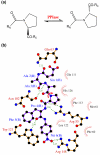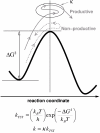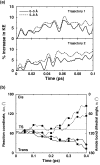Enzymes: An integrated view of structure, dynamics and function
- PMID: 16409630
- PMCID: PMC1379655
- DOI: 10.1186/1475-2859-5-2
Enzymes: An integrated view of structure, dynamics and function
Abstract
Microbes utilize enzymes to perform a variety of functions. Enzymes are biocatalysts working as highly efficient machines at the molecular level. In the past, enzymes have been viewed as static entities and their function has been explained on the basis of direct structural interactions between the enzyme and the substrate. A variety of experimental and computational techniques, however, continue to reveal that proteins are dynamically active machines, with various parts exhibiting internal motions at a wide range of time-scales. Increasing evidence also indicates that these internal protein motions play a role in promoting protein function such as enzyme catalysis. Moreover, the thermodynamical fluctuations of the solvent, surrounding the protein, have an impact on internal protein motions and, therefore, on enzyme function. In this review, we describe recent biochemical and theoretical investigations of internal protein dynamics linked to enzyme catalysis. In the enzyme cyclophilin A, investigations have lead to the discovery of a network of protein vibrations promoting catalysis. Cyclophilin A catalyzes peptidyl-prolyl cis/trans isomerization in a variety of peptide and protein substrates. Recent studies of cyclophilin A are discussed in detail and other enzymes (dihydrofolate reductase and liver alcohol dehydrogenase) where similar discoveries have been reported are also briefly discussed. The detailed characterization of the discovered networks indicates that protein dynamics plays a role in rate-enhancement achieved by enzymes. An integrated view of enzyme structure, dynamics and function have wide implications in understanding allosteric and co-operative effects, as well as protein engineering of more efficient enzymes and novel drug design.
Figures









Similar articles
-
Role of protein dynamics in reaction rate enhancement by enzymes.J Am Chem Soc. 2005 Nov 2;127(43):15248-56. doi: 10.1021/ja055251s. J Am Chem Soc. 2005. PMID: 16248667
-
Protein dynamics and enzymatic catalysis: investigating the peptidyl-prolyl cis-trans isomerization activity of cyclophilin A.Biochemistry. 2004 Aug 24;43(33):10605-18. doi: 10.1021/bi0495228. Biochemistry. 2004. PMID: 15311922
-
Cis/trans isomerization in HIV-1 capsid protein catalyzed by cyclophilin A: insights from computational and theoretical studies.Proteins. 2004 Aug 15;56(3):449-63. doi: 10.1002/prot.20135. Proteins. 2004. PMID: 15229879
-
Protein conformational populations and functionally relevant substates.Acc Chem Res. 2014 Jan 21;47(1):149-56. doi: 10.1021/ar400084s. Epub 2013 Aug 29. Acc Chem Res. 2014. PMID: 23988159 Review.
-
Computational perspective and evaluation of plausible catalytic mechanisms of peptidyl-prolyl cis-trans isomerases.Biochim Biophys Acta. 2015 Oct;1850(10):1994-2004. doi: 10.1016/j.bbagen.2014.12.023. Epub 2015 Jan 10. Biochim Biophys Acta. 2015. PMID: 25585011 Review.
Cited by
-
The Statistical Trends of Protein Evolution: A Lesson from AlphaFold Database.Mol Biol Evol. 2022 Oct 7;39(10):msac197. doi: 10.1093/molbev/msac197. Mol Biol Evol. 2022. PMID: 36108094 Free PMC article.
-
Repurposing Modular Polyketide Synthases and Non-ribosomal Peptide Synthetases for Novel Chemical Biosynthesis.Front Mol Biosci. 2020 May 15;7:87. doi: 10.3389/fmolb.2020.00087. eCollection 2020. Front Mol Biosci. 2020. PMID: 32500080 Free PMC article. Review.
-
Thermostable enzyme research advances: a bibliometric analysis.J Genet Eng Biotechnol. 2023 Mar 27;21(1):37. doi: 10.1186/s43141-023-00494-w. J Genet Eng Biotechnol. 2023. PMID: 36971917 Free PMC article. Review.
-
Conformational Sub-states and Populations in Enzyme Catalysis.Methods Enzymol. 2016;578:273-97. doi: 10.1016/bs.mie.2016.05.023. Epub 2016 Jul 9. Methods Enzymol. 2016. PMID: 27497171 Free PMC article. Review.
-
A Biophysical Perspective on Enzyme Catalysis.Biochemistry. 2019 Feb 12;58(6):438-449. doi: 10.1021/acs.biochem.8b01004. Epub 2018 Dec 18. Biochemistry. 2019. PMID: 30507164 Free PMC article.
References
LinkOut - more resources
Full Text Sources
Other Literature Sources
Miscellaneous

